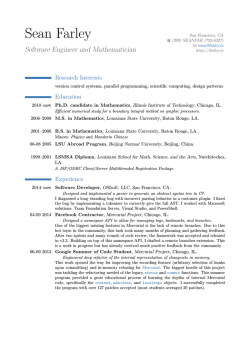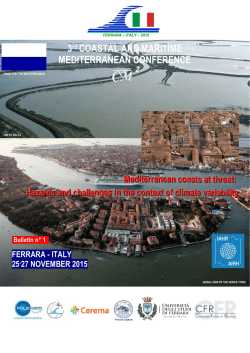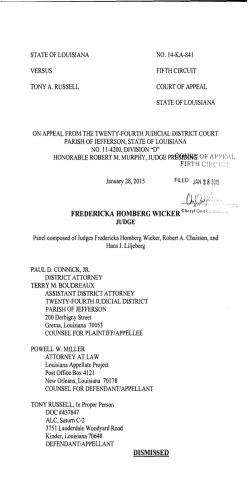
i-~:_ ~eEH-EHGIHEERINGr - Woods Hole Oceanographic Institution
~i-~:_ ~eEH-EHGIHEERINGr----... ~ =iHD THE =EHVIROM E H l - - - - - CONFERENCE RECORD · NOVEi'v1BER 12-14, 1985 SAN DIEGO, CALIFORNIA SPONSORED BY: Marine Technology Society · ~ ~- IEEE Ocean Engineering Society • ----,----·---·--·----- ¥ObUM~1--- -·-·- - - - - - - - - - - - - - J . J ·E-IWQ_ - - - - - - _ _ _ _ _·- -=___JI "The Louisiana Response to Land Subsidence & Coastal Erosion" Maynard Silval ·Mark Meo 2 Marine Policy and Ocean Management Centerl Woods Hole Oceanographic Institution Science and Public Policy Program2 University of Oklahoma ABSTRACT Based on interviews with representatives of state, loca: and federal agencies and with private interests, this papers reviews and assesses the responses made in Louisiana to the related problems of land subsidence and coastal erosion, The paper begins with a short review of the scientific evidence lotlich indicates that Louisiana is losing more than 40 square miles per vear to these phenomena. The paper then examines ~he process by lotlich the variou.~ agencies involved have created policies and programs for addressing the problems of subsidence and erosion. The authors then enumerate the various strate!!ies loklich have been adopted. The paper conclud.;,s with a feo.: observations on the adequacy 0f the stc•te, federal, local and private responses. INTRODUCTION Louisiana is annually losing a por_tion of its coastline. Some estimates put that loss at some fifty square miles per year. In a broad sense, this submersion of Louisiana coastline by the Gulf of ~\exico can be traced to two related but some~oflat different rhysical phenomena--subsidence ;me coastal erosion. Both rrocesses have merited s c i en t i f i c a t ten t i on in the pas t wi t h on 1 y limited public policy concern, yet so rapid has the rate of land loss accelerated over the last several decades that public concern to resolve the dilemma in some accept able manner has become wi des pr ead • This paper examines ...tlat the response of Louisiana has been to this quite significant land loss. In stating that we will be examining the response of Louisiana, we are not implying that we will be focusing only on the activities of the state government of the Louisiana. Quite the contrary, our research has indicated that in terms of land loss in coastal Louisiana "response" has to be viewed quite broadly. Indeed the Louisiana response to this environmental problem must be interpreted as including the projects and activities of a diverse group of actors. We have identified public and private entities at the local, state, and national levels loklich are involved in the response to the coastal land loss in Louisiana. for example, the U. S. Army Corps of Engineers (ACE) is presently conducting feasibility studies for controlled diversions of the Mississippi River into Lake Pontchartrain and the Barataria Basin. ·Although these studies are part of a project requested more than two decades ago, they have become noticeably prominent at present. The State response in the form of a Coastal Protection Trust fund was enacted in 1980 and developed in the form of " master plan by 1984, This year the Trust was increased -by SSO million over the original allocation of S35 million. At the local level, parishes confronted with losses of productive marshland have instituted action plans designed to dampen the impacts associated with subsidence and erosion. Based on a review of the literature and interviews, this paper is comprised of three sections. Sectior. I looks at land loss in ~oa~tal Louisiana. We review the evidence and examine the causes which have been suggested, Section I also elaborates on the socio-economic consequences of the phenomenon. Section II identifies th~ numerous actors involved and the processes and policies that have been adopted, The paper concludes with Section III which offer's our analysis of the adequacy of the responses, LAND LOSS IN COASTAL LOUISIANA Land loss in coastal Louisiana is a complex phenomenon. No single factor can be cited as the sole cause. The factors suggested as being casusative in this case are both natural and anthropogenic. The broad expanse of Louisiana's coastal wetlands have arisen from the. discharge of sediment and nutrient laden waters spilled by the lower Mississippi River as it- meandered over the lowlying flood plain (Coastal Environments, Inc., 1982). The present bird foot delta which is constrained from further course changes by river and distributary levees has passed its peak delta building stage, and is u•·-.dergoing a period of natural decline, Navigation and flood control structures built along the River's channels have precluded supply of nutrient-rich sediments to interdistributary marshes and hence have been found to be subsiding. In addition canals which have been excavated in the course of exploring for oil and gas deposits 1.n1derlying the marsh have enabled saline waters to intrude into interior marsh habitats. Fresh water and intermediate salinity marsh plant communities have been relocated landward. Channel erosion along the 1.n1protected canal walls has also 594 L - - - - - - - - _ _ _ _ _ _ _ _ _ _ _ _ _ _ _ _ _ _ _ _ _ _ _ __j!l":_ Ti r< dE Cl L< f; 2 ti 3 r:T t' d d 5 f contributed to an increase in wetlands loss. Aerial surveys taken over the last two decades have provided evidence by \oklich the increasing rate of coastal land loss has been measured. In 1974 it was estimated that coastal wetlands were eroding at a rate of 16 square miles per year; by 1983. the rate of annual wetland loss was estimated between 40 and 50 square miles (Louisiana State and Senate Satural Resources Committee, 1981; Coastal Environments, Inc., 1982). The cumulative impacts of subsidence and canal excavation have been exerted differentially across the coastal region. The Coastal Protection Task Force has reported that Terrebonne Parish has lost as !DUCh as 42% of its barrier island acreage (1984). The present rate of subsidence has contributed to a rise in relative sea level at a rate estimated to be one meter per century (Barth ·and Titus, 1984) If carbon. dioxide accumulation in the atmosphet;e resulting from fossil fuel combustion leads to a global warming through the ''greenhouse effect", eustatic sea level could rise as much as four feet by 2100 (Barth and Titus, 1984). There is some e"idence that the rate of sea level rise has increased in recent decades (Aubrey, 1984). This may have exacerbated the land loss problems in Louisiana. There are several categories of negative consequences associated with coastal land loss in Louisiana. Below we will briefly elaborate on fi"e of the more important~ 1) the land itself, 2) loss of economic activities ~ssociated with the wildlife and habitats of coastal Louisiana, 3) losses of state revenues deri"ed from minerals on submerged lands, 4) salt water intrusion into the water suppl:y of metropolitan areas, and, 5) decreased protection from storm (hurricane) damage. These categories are generally supported by a statement from a joint report from the Louisiana Senate and House Commit tees on Natural Resources. The impact of such land loss can be directly translated into millions of dollars in revenues lost to the state fisc and to its citizens. The economic impact· extends to coastal demographics--services distrupted if not terminated; homes, business and industries displaced by encroachment by the sea, hurricane protection wiped out ( 1981). In considering land loss in Louisiana, the most important fact to remember is that we are discussing wetlands. This is important because wetlands tend to be one of the most biologically productive environments. As will be seen shortly, they make economic contributions in many ways. Also important to remember is a second fact--" South Lou is iana' s 6. 5 million acres of coastal wetlands accout for 40% of the nation's marsh ecosystems." (Davis, 1983) Some idea of the ~gnitude of the problem merely in terms of the land to be lost can be gained from some rather startling statistics. Given current rates of land loss to subsidence and erosion (for the moment ignoring t~e possibility of increase in the rate at which sea level is rising, Plaquemines Parish will have disappeared beneath the surface of the Gulf of Mexico in approximately 50 years; Terrebonne in approximately 100 years (Louisiana Senate and House Natural Resources Committees, 1981). These statistics say nothing of the non-market values of the resources which will be lost (Gosselink., 1984). One of the ros t important aspects of the coastal Louisiana marsh/wetlands environment is its ability to sustain a large variety of economically-important species. These include shell fish and finfish as well as fur-bearing animals. Also important are the fish, fowl, and game animals which support a thriving sports hunting and fishing industry. This Louisiana fishery is dependent primarily on the American oyster (Crassos trea virginica ( Gmel in)). In recen c years approximate 1 y 200 ,000 acres of oyster beds have been harvested by more than 1300 fee paying lease holders. These oystermen produce on average 9 million pounds of meat with an exvessel value of $3 to $4 million. (Davis, 1983) The continued existence of this fishery is threatened by land loss because of the dual threat of saline intrusion; not only is the oyster drill (Thais haemastoma canaliculata (Gray) able to in"ade previously protected oyster habitat but vital low salinity seed oyster habitat will be lost (Chatry et al., 1983). Like oysters, brown and white~ shrimp (Penaeid sp.) are dependent on marshes and wetlands primarily for the nursery habitat and food resources that they provide for anadramous postlarvae. 'With an annual value in the tens of millions, this is Louisiana's mst important commercial fishery. (Davis, 1983) Several of Louisiana's small coastal ports consistently rank among this nation's top ports in terms of the value of the shrimp landings. (NMFS, 1984, 1983, 1983; Craig et al., 1979) The economic value of Gulf menhaden (Brevoortia patr.onus), which is also estuarine dependent, is related to its high oil content. After capture, this species is processed into fishmeal and fishoil for use as animal feed. This fishery harvests between 600 million and 1+ billion pounds annually, which equates with a dollar value of approximately SlO million (Davis, 1983). An aspect of the coastal Louisiana economy which is not widely known is its production of pelts from marsh dwellers such as the 111.1skrat and the nutria (a fur bearer accidentally introduced from Argentina). This small area of the United States produces approximately 65% of the country's annual harvest of furs. In so doing, it provides important winter employment for several thousand trappers. The value of the yearly harvest can top $24 million (Davis, 1983). Davis (1983) has indicated the importance of the area's sporting species to the economy of Louisiana. By sporting species we are referring to the waterfowl, game, and fish which are valued by sportsmen. His calculations placed the species annua 1 contribution to the Louis ian a economy at between $175 and $200 million. Another source uf potential economic loss for 595 Louisianans pertains to revenues of the state ~overnment derived from mineral re~ources (i.e., oil and gas) on state lands. Part of these lands are in the ocean in the area between the shoreline and the outer edge of the three-mile terri tor ial sea. Resources beyond the three-mile line fall under the jurisdiction of the federal government. With jurisdiction over fossil fuels comes the right to garner royalty and bonus payments. An unresolved issue is, if the coastline of Louisiana continues to recede, will the state lose revenues as resources currently tD1der their jurisdiction technically become part of the purview of the U.S. Department of the Interior? If so, Louisiana could lose hundreds of millions of dollars in revenues (Louisiana Geological Survey, 1985). Saltwater in tr us ion can also cause economic losses. As the coast moves landward, saltwater can intrude inland through the marshes and up the rivers and streams. Houma, in Terrebonne parish, has already experienced elevated salinity levels in its water supplies during the summer months (Terrebonne Parish Government, 1985). The city of New Orleans has expressed some concern that their water intake in the Mississippi river might be threatened (New Orleans Planning Commission, 1985). Finally, the wetlands and barrier beaches of the coast protect inland areas from the periodic ravages of storm and hurricane surges. Without the protection of these impediments to storm surge one could expect major increases in the costs associated with natural disasters either from increased damages or increased protection .;;~ts_. For example, if, as projected, Terrebonne Parish were to lose its barrier islands, "drastic increase in the cost of providing hurricane protection for the 200,000 residents of the Terrebonne-Lafourche Metro Area can be expected" (CPTF Report, 1984). THE RESPONSE TO COASTAL LAND LOSS The public's emerging awareness and its translation into political concern for coastal land loss has been sparked primarily by three factors; fishermen's and trapper's visual observations of water encroachment upon commercially exploited wetlands; belief that subsidence could lead to a landward relocation of the boundary separating Louisiana's territorial waters from those of the federal governments; and finally, the communication by Dr. Sherwood Gagliano of the implications of incremental land loss to residents of coastal Louisiana in terms understandable to the affected public. Gagliano's characterization of rates of land loss calc;.~lated for several coastal parishes as years remaining for each region is credited with galvanizing local interests into action ( LSU, Center for Wetlands Research, 1985; Plaquemines Parish Government, 1985). This public awareness has been converted into policies and projects at all levels of government. Those closest to the problem, that is the coastal parishes, have been the most active. The two most threatened parishes are Plaquemines and Terrebonne. Each is projected to have little more than half a century remaining. Both parishes have initiated programs designed to 596 dampen the ma jar impacts associated with land loss. The progra1r. of Plaquemines Parish enjoy unanimous political support. It has incorporated the use of several freshwater siphons to retard saline intrusion. It is also actively promoting the use of strategic breaks in the levees along the river by the ACE to build new wetlands. Earlier efforts included an attempt to replenish sediment along the Chandeleur 1 sland barrier chain, but were vetoed by the National Park Service (Plaquemines Parish Governi!Ent, 1985). To provide sufficient time to conduct a final retreat from the encroaching wat~rs, a barrier dike is under consideration. It is expected that the parish will have to be abandoned when waves begin to lap against this levee. In addition to structural and nonstructural options, Plaquemines Parish is also conducting a vigorous education campaign (Plaquemines Parish Government, 1985). Terrebonne Parish lies to the west of the Mississippi River. The region at present is experiencing a variety of subsidence related problems. To address these interrelated problems the parish has devised a comprehensive response that has sparked a good amount of interest statewide. The parish plan is driven by four program goals; 1) develop a comprehensive data base; 2) educate the public; 3) preserve the wetlands; and 4) preserve the barrier islands. Achievement of the data base goal will include tasks such as an inventory of sand resources, a marsh valuation study, and an oyster contamination study. The broad education program includes slide presentations, handouts, use of billboards, the development of a foundation to support barrier island conservation and a curriculum for junior high school. The preservation wetlands involves fourteen separate management efforts which include· private companies (e.g. Tenneco La Terre), state agencies (e.g. Louisiana Department of Wildlife and Fisheries, Department of Natural Resources) and federal agencies (e.g. ACE, EPA). Progress in barrier island beach nourishment and stabilization has been made. By 1983 the parish had completed two restoration plans. While the parish awaits completion by the ACE of its wetlands studies, the main focus for its activities will remain barrier island restoration. However, the most provocative project proposed by the parish for protecting the wetlands consists of a closure dike program first suggested by the ACE as a possible structural remedy. A closure dike once in place would resemble a polder that would provide tidal exchange. The state office of coastal zone management has undertaken a study to evaluate the practicability of this proposal. At the state level, several executive agencies have been invol 'ved. So have the two houses of the Louisiana legislature. By 1981 several state legislators had become aware of the magnitude of the land loss problem. Fearful that the state stood to lose oil and gas royalties if the state-federal boundary should be moved landward, Senator Samuel Nunez instructed one of his staff to prepare a report on the problem with a list of recommendations. Pursuant to the preparation of this report, legislation was enacted lolilich provided for a Coastal Protection Trust Fund with an endowment of $35 million for project development (CPTF, 1982). The responsibilitY for project management was accorded to the Louisiana Geological Survey of the Department of Satural Resources. Two years after passage, Senator Nunez held hearings in August of 1983 to revie~o~ the progress made. Distressed both by the interest earned by the trust fund and by the absence of any project under development or any plan for implementing the l~gislation, the Geological Survey was given 90 days to produce a master plan. The state's master plan, developed in 1984, is separated in to two dis tinct five-year phases. Phase I program elements include the implementation of existing projects, barrier and shoreline restoration projects, coastal vegetation program, and the development of a wetland protection prograc~. It has been estimated that barrier island stabilization will require $131 million for the first five years. Phase II program elements include beach nourishment projects, dune vegetation and stabilization, and imolementation of the wetland protection program. This latter element presents severe obstacles for the state program which will require extensive intergovernmental cooperation to overcore. This is because the issues to be dealt with in wet 1 ands management are much more difficult than these in the shoreline protection and barrier islands stabilization phase. (Louisiana Geological Survey, 1985) As the state's response to land loss has gained momentl.DD, interested legislators have coalesced into an informal group known as the "coastal caucus". They have toured severely impacted areas of the coast and have kept abreast of agency developments, Generally, the caucus has served to broaden the base of political support in south Louisiana and maintain interest in the land loss issue. In the 1985 legislative session, for example, an additional $50 million was allocated to the Coastal Environment Protection Trust Fund from funds held in escrow pending the settlement of litigation between the United States and Louisiana over revenues from oil and gas deposits lolilich underlie the current three-mile line in the Gulf of Mexico, The federal presence in coastal Louisiana is primarily the result of efforts undertaken by the ACE to protect the Lower Mississippi River floodplain from periodic flooding, to maintain navigable waterways including inland ports, and to provide protection for the port city of New Orleans. The ACE has been involved in studies of the Louisiana coastal region since 1967 when both the U.S. Senate and House committees adopted identical resolutions empowering the ACE to "determine the advisability of improvements or modifications to existing improvements in the coastal area of Louisiana in the interest of hurricane protection, prevention of salt water intrusion, preservation of fish and wildlife, prevention of erosion, and related resource purposes", Since 1967 the ACE has sponsored a number of environmental studies of the coastal area. ln addition to ACE studies, research has been undertaken by the U.S. Fish and Wildlife Service, the Louisiana Department of Wildlife and Fisheries, the National Marine Fisheries Service, and the Center for Wetland Resources at Louisiana State University. Since 1980 the ACE has published several studies of ~mportance to the land loss problem. These include feas ibil: ty reports on freshwater diversions from the Mississippi River into Barataria and Breton Sound Bas ins as well as for discharge into l.ak.e Pontchartrain (ACE, 1985). The river diversion projects at Caenarvon and Davis Pond locations are especially appealing for several reasons. They will 1) help to retard saline intrusion and help res tore valuable oyster habitat, 2) provide sediment for marsh creation which offset subsidence, and 3) provid·e valuable engineering guidance for the state coastal protection program. Under current funding agreements the state will pay for the diversion structure's operating costs. Research undertaken by the Department of Wildlife and Fisheries has confirmed the relationship between the 15 ppt isohaline contour and oyster productivity. The timing and rate of discharge of the river diversion, scheduled for completion by 1986, is important to optimize oyster harvests (Chatry, 1985). Although river diversions have been discussed for decades, they have failed to meet either economic feasibility tests (i.e. benefit-cost ratio greater than unity) or sociopolitical acceptance. The present ACE practice for estimating and measuring project benefits under the Water Resources Council's "Principles and Guidelines" does not avail itself to the inclusion of the extramarket social benefits and values endemic to wetlands. The state has started to review conceptual and operational techniques for natural resource valuation. loTh en complete, these studies should help to aid the revision of benefit-cost procedures used in project evaluation in the coastal protection program. Although it is constrained in practice by the limitations of "Principles and Guidelines··, the ACE has encouraged the use of new economic valuation techniques and has supported methods for ranking wetland functions and values. A revision of wetland evaluation techniques is an important aspect of the second phase of the state's master plan because a priori agreement should be reached on the comparative social benefits and costs that each potential course of action generates • Another federal agency involved in the -coastal protection program is the Federal Emergency Management Administration (FEMA). Although it does not play a direct role in the coastal protection program, its separate activities affect coastal policies. Through its insurance programs, FEMA sets the rates for coastal properties within membership categories. Risk assessments are based upon hindcasts of hydrological and meterological records and rates are determined to reflect the established rates. The primary private participants in the Louisiana response have been from academic institutions (and perhaps better labeled as quasi-private) and major land holders, primarily 597 . ' oil and gas exploration companies, in southern Louisiana. The primary academic actors have included LSU • s Center for Wetland Resources and the Gulf South Research Institute. ln a jointly published document in 1982, these two institutions stated their reservations about the states approach to land subsidence and coastal erosion. Succinctly, they argued that Louisiana was approaching the problem from a position of basic ignorance. Further, given the complexity of coastal processes in the state's wetlands, this could only lead to failure. Correspondingly, the GSRI-LSU approach would see greater amounts of available ftmds dedicated to research on the region. Specifically, they proposed that it was necessary to better understand the processes at work in the region, Based on this improved understanding, it would then be possible to construct a model of wetlands loss, Then using the model it would be possible ~o predict future conditions and suggest appropriate management alternatives. The cost of the this effort was projected at between $450,000 and $550,000. (Gulf South Research Institute and LSU, 1982) Also, LUMOON, the Louisiana University Marine ConsortilDD, should be considered among the important academic players (Boesch, 1982). Tenneco is one of the largest land owners in southern Lousiana, As elseWhere, Tenneco is a major corporation involved with a variety of natural resources, One of it major holding is LaTerre near the city of Houma. Primarily concerned with the exploitation of oil and gas resources, Tenneco-LaTerre also manages its extensive wetlands for wildlife resources which can be trapped or htmted. Tenneco's LaTerre project is basically one of mitigation banking, The company is setting aside 5,000 acres which will be protected by weirs, bulkheads, and mud dams. These lands will be used to offset losses to wetlands res.ulting from oil canals that they dredge (Anonymous, 1984), From the above discussion, it can be seen that a variety of strategies have been adopted by those taking part in the Louisiana repsonse to subsidence and erosion. There are several strategies which have been adopted or are seriously being considered to counter the problem of land loss. Among these are beach nourishment, fresh water diversions, dikes and polders, mitigation measures and additional study. While most of these are quite different reactions to the problem, in most cases they are not mutually exclusive, Indeed most of the strategies are suggested in the Coastal Protection Trust Fund ( CPTF) plans. In this regard, the CPTF can be viewed as the keystone, That is, it is generally establiShing the acceptable boundaries for activities, It was seen above that many of the strategies which have been endorsed by inclusion in the project list of the CPTF are being carried out much more expeditiously by other entities. As part of the general strategy of forestalling barrier beach erosion until such time as concerted marsh management can be undertaken, both the state of Louisiana and the par ish of Terrebonne are working on sand 598 nourishment projects. To counter the sediment lost to the marshes because of the channelization of the 11ississippi, one of the favored strategies is that of fresh water diversions. That is, it is argued that facilities should be constructed to enable the periodic diversion of sediment-rich waters into the marshes. This approach is predominantly at the discussion stage, but it is one favored by virtually all of the agencies and private individuals we had contact with, lt has been suggested that a system of dikes and polders could alleviate the problem, This appr each, basically turning the south of Louisiana into a Netherlands on the Gulf of Mexico is predominantly favorecl by Terrebonne Parish. It is their objective to build a system of dikes and polders virtually across the breadth of the state-from Texas to Mississippi. (Terrebonne Parish Government, 1985) Mitigation is another strategy. This is Tenneco-LaTerre 's major contribution to the Louisiana response. They are attempting to rebuild wetlands destroyed by canal dredging. The Corps of Engineers is probably the rost significant agency stressing the strategy of more study. They have recently funded a number of studies to look at the severity of the land loss problem in southern Louisiana. These studies will include an analysis of the potential remedies, What is interesting about these studies is that they were originally authorized in 1966 (ACE, 1985). They are joined by the academic interests involved. CONCLUSIONS One of the recurring themes in the debate over which courses of action to pursue for coastal protection is the limited scientific knowledge available on the structure and function of coastal ecosystems. Given the strong public pressures for projects to be undertaken expeditiosly, intergovernmental cooperation will be critical for the exchange of valuable technical information and experience. Meetings among university researchers, state agencies and federal agencies have been frequent, yet a well defined planning philosophy within which the complex issues associated with coastal protection can be implemented has yet to emerge. What we have found is that there has been a broad recognition of the land loss problems of coastal Louis ian a. This recognition has generated a variety of responses by public as well as private actors at the federal, state and local levels. There are two primary lessons to be learned from the Louisiana experience, First, with any acute and predictable environmental problem such as this, the ··response" will be the aggregate of many responses emanating from all levels. The agencies are there and they have jurisdictions and regulatory mandates pertinent to the problem. Further, the agencies are unwilling to ignore the problem while others act. Inaction could result in a loss of bureaucratic "turf" or flexibility. Thus environmental problems of this sort will always generate and require an intergovernDEntal effort. Second, the federalism or intergovernmental . - . ~ aspect, vhUe necessary can create a problem. That problem is derived from the anomalies that exist in the planning horizons of the various agencies taking part in the response. We have stated that the most active agencies have been the local parishes. In part this reflects their planning horizons. lolh ile most of the relevant actors can agree on \olhat should be done, they cannot agree on when and at what pace it shpuld occur, Understandably, the parishes want something done now. Federal agencies do not labor under the same urgency. Unfortunately, there appears to have been some animosity generated because of these different planning horizons. If they are not mediated, the efforts in coastal Louisiana could be wasted. The enormity of the problem requires that all those who have been involved cooperate to the fullest extent possible. If i t does not continue to be a "federal" response, the activities to counter land loss in Louisiana will probably be in vain. ACKNOWLEDGEMENTS This project was supported by the U.S. Department of Commerce, Office of Sea Grant NA84AA-D-0033 (RS/13), the J.N. Pew, Jr. Charitabl.e Trust, and the Woods Hole Oceanographic's Marine Policy and Ocean Management Center, REFERENCES ACE (Army Corps of Engineers), 1985, with relevant staff. Interviews Gosselink, J.G. 1984. The. ecology of delta marshes of coastal Louisiana:· a commuinty profile. U.S. Fish and Wildlife service. FWS/OBS-84/09. 134 pp. Gulf South Research Institute and Louisiana State University (Center forWetland Resources), 1982. "Position Paper on Approach to Projecting Future Coastal Conditions," pp. iv + 17. Louis,iana, Department of Natural ·Resources, n.d. "Recommendations for Freshwater Diversion to Barataria Basin, Louisiana." Coastal Management Section, Baton Rouge. Louisiana, Department of Natural Resources (CPTF Report), 1982, "Coastal Protection Task Force Report to Governor David C. Treen and to the Joint House and Senate Committees on Natural Resources and to the Legislative Budget Committee," Louisiana, Department of Natural Resources (CPTF Report), 1984. "Coastal Protection Task Force Report to Govenor Edwin W. Edwards and to the House and Senate Committees on Natural Resources and to the Legislative Budget Committee," Louisiana, Geological Survey, 1985, with relevant staff. Interviews Ai:l0n)'111ous, 1984. "The delicate balance." Tenneco, XVIII, No. 3, pp. 1-6. Louisiana, Legislature. Senate and House. Committees on ~atural Resources. 1981. Report on Special Projects for Coas~al Louisiana-co-the Govenor and the Legislature, October 12, 1981, iii + 37 p. Barth, Michael C., and James G. TITUS (eds.), 1984, Greenhouse Effect and Sea Level Rise. Van Nostrand Reinhold Co., Sew York, 325 pp. Louisiana. Revised Statutes, vol. 30, chap. 5-A. "Coastal Environment Protections Trust Fund," 23 November 1981. Boesch, D. F. (ed.), 1982. Proceedings of the Conference on Coastal Erosion and Wetland Modification in Louisiana: Causes, Consequences, and Options. U.S. Fish and Wildlife Service, Biological Services Program, WaShington, D.C. FWS/OBS-82/59, 256 p. LSU, Center for Wetlands· Resources, 1985. Interviews with relevant staff. Chatry, ~ark, Ronald J. Dugas, and Kirk A. Eastley, 1983. · "Optimum Salinity Regime for Oyster Production on Louisiana's State Seed Grounds." Coastal Environments, Inc., 1982, "Louisiana's Eroding Coastline: Recommendations for Protection," Prepared for the Coastal Management Section of the Louisiana Department of Natural Resources. Baton Rouge, Louisiana. Craig, N. J., R, E. Turner, and J. W. Day Jr., 1979, "Land Loss in Coastal Louisiana." Environmental Management, Vol. 3, No, 2, pp. 133 144. Davis, Donald W., 1983, "Economic and Cultural Consequences of Land Loss in Louisiana." Shore and Beach, October 1983, pp. 30-39. New Orleans Planning Commission, 19S5. Interviews with relevant staff. Plaquemines Parish Government, 1985, with relevant staff. Terrebonne Parish Government, 1985. with relevant staff. Interviews Interviews
© Copyright 2025







